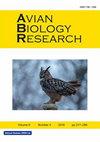Keratinolytic bacteria from the feathers of wild Dark-eyed Juncos (Junco hyemalis)
IF 1.2
4区 农林科学
Q4 AGRICULTURE, DAIRY & ANIMAL SCIENCE
引用次数: 0
Abstract
We collected >300 bacterial isolates from overwintering Dark-eyed Juncos (Junco hyemalis) to find that ∼40% appear to degrade the structural protein of feathers using extracellular keratinase enzymes. A guild of bacteria (∼18% of total counts) grew significantly better on basal salt medium (BSM) plates containing feather meal than on BSM agar-only plates (∼8% total counts). The genus-level profile of the 107 most active keratinolytic bacterial isolates shows that nearly half are Bacillus species. Keratinolytic Frigoribacterium, Microbacterium, Okibacterium, Pantoea, Sphingomonas, Staphylococcus, and Stenotrophomonas were found, among others. Active isolates were shown to degrade whole feathers, used feather meal as a sole carbon and energy source, and produced zones of clearing indicative of extracellular proteases on milk agar plates. Our novel in vitro keratinase assay uses ninhydrin to quantitate the release of amino acids from exogenously added keratin, with Bacillus licheniformis str. ATCC 14580 serving as a positive control. Keratinolytic isolates were grown in the presence of feather meal to induce keratinase release and this conditioned medium, called the enzyme extract, was clarified by centrifugation and filtration. The enzyme reaction was completed in 30 min and was positively correlated with the amount of extract added, until reaching color saturation. Bacillus pumilus str. F166 was the most active isolate and Bacillus cereus str. F65 was about half as active as the positive control. Bacillus cereus str. F27 performed well too. We also have demonstrated strong keratinolytic activity against raw wool α-keratin. Juncos are long-distance migrant birds that carry bacteria on their feathers, both beneficial and harmful to plants. The abundant keratinolytic bacteria on feathers are capable of structurally damaging the feathers, potentially reducing bird fitness and reproductive success. Keratinases have uses in tanning, silage, and remediation. Keratinases may be useful in the treatment of onychomycoses and actinic keratoses in medical and veterinary settings.野生黑眼Juncos(Junco hyemalis)羽毛中的角质分解菌
我们从越冬的黑眼Juncos(Junco-hyemalis)中收集了300多个细菌分离株,发现约40%的细菌似乎使用细胞外角蛋白酶降解了羽毛的结构蛋白。在含有羽毛粉的基础盐培养基(BSM)平板上,细菌群(约占总计数的18%)的生长明显好于仅在BSM琼脂平板上(约占总数的8%)。107个最具活性的解角蛋白细菌分离株的属级图谱显示,近一半是芽孢杆菌。除其他外,还发现了溶角质Frigoribacterium、Microbacterium、OkibacteriumPantea、鞘氨醇单胞菌、葡萄球菌和狭窄单胞菌。活性分离株可降解整根羽毛,将羽毛粉用作唯一的碳和能量来源,并在牛奶琼脂平板上产生指示细胞外蛋白酶的清除区。我们新的体外角蛋白酶测定法使用茚三酮来定量外源性添加角蛋白中氨基酸的释放,地衣芽孢杆菌ATCC 14580作为阳性对照。在羽毛粉存在的情况下生长角蛋白分解分离株,以诱导角蛋白酶释放,并通过离心和过滤澄清这种条件培养基,称为酶提取物。酶反应在30分钟内完成,并且与提取物的添加量呈正相关,直到达到颜色饱和。短小芽孢杆菌(Bacillus pumilus str.F166)是最具活性的分离物,蜡样芽孢杆菌(Bacillus cereus str.F65)的活性约为阳性对照的一半。蜡样芽孢杆菌(Bacillus cereus str.F27)也表现良好。我们还证明了对生羊毛α-角蛋白的强解角蛋白活性。Juncos是长距离迁徙的鸟类,羽毛上携带细菌,对植物有益也有害。羽毛上丰富的角蛋白分解细菌能够在结构上破坏羽毛,可能会降低鸟类的健康状况和繁殖成功率。角蛋白酶可用于制革、青贮和修复。在医疗和兽医环境中,角膜溃疡可用于治疗甲真菌病和光化性角膜溃疡。
本文章由计算机程序翻译,如有差异,请以英文原文为准。
求助全文
约1分钟内获得全文
求助全文
来源期刊

Avian Biology Research
农林科学-奶制品与动物科学
CiteScore
1.50
自引率
0.00%
发文量
17
审稿时长
2 months
期刊介绍:
Avian Biology Research provides a forum for the publication of research in every field of ornithology. It covers all aspects of pure and applied ornithology for wild or captive species as well as research that does not readily fit within the publication objectives of other ornithological journals. By considering a wide range of research fields for publication, Avian Biology Research provides a forum for people working in every field of ornithology.
 求助内容:
求助内容: 应助结果提醒方式:
应助结果提醒方式:


